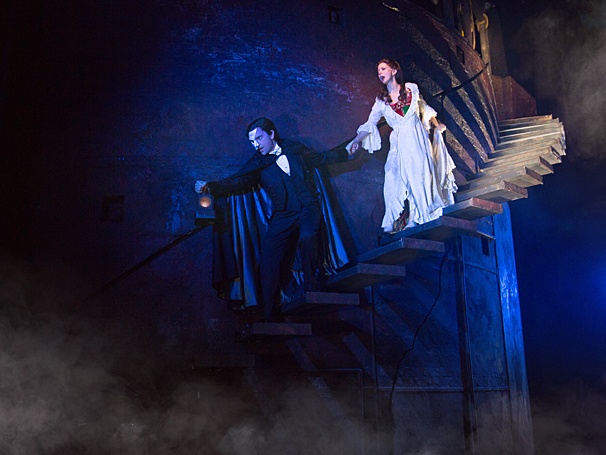Chris Mann & Katie Travis in The Phantom of the Opera.
Photo courtesy of Broadway.com
The Phantom of the Opera
Music by Andrew Lloyd Webber, Lyrics by Charles Hart & Richard Stilgoe
Book by Richard Stilgoe & Andrew Lloyd Webber
Directed by Laurence Connor
Review by Kathi E. B. Ellis
Entire contents copyright © 2016 by Kathi E. B. Ellis. All rights reserved
The iconic half-mask of Andrew Lloyd Webber’s Phantom of the Opera is one of the most recognizable theatrical images worldwide, known to non-theatregoers and to theatre aficionados alike. The 2015-2016 Broadway in Louisville season ends this month with a two-week run of the now thirty-year old classic, billed as ‘the spectacular, new production.’
For those who have seen every touring version, and/or the Broadway production, and/or recorded excerpts, there is much that is still recognizable in this production. There is, of course, the afore-mentioned mask, the boat and ‘the’ chandelier. Director Laurence Connor and designers Paul Brown (set), Christine Rowland (costumes, reconceiving the late Maria Björnson’s vision), Paule Constable (lighting, whose work was also seen in Louisville in War Horse, 2013), and Nina Dunn (video and projection) have created a spectacle that moves fluidly from stage to dressing room, from the rooftop to the dungeons of the Paris Opera.
The centerpiece of this reimagined Phantom is the cylindrical rotating structure that facilitates the fluidity of moving around the Paris Opera. Most compelling is the descent into the dungeons, with the downward steps emerging from the wall, as they are needed, creating a vertiginous descent. The scenes with the Phantom (Chris Mann) and Christine (Katie Travis) in the boat are oddly apposite this week, with news stories of the rising River Seine reminding us that many cultural institutions in Paris are located over this body of water. The swathed chandelier broods over the audience from the time the house is open, is spectacularly revealed, and the pyrotechnics are suitably effective for the act one climax.
Integrating video and projections into the design is elegantly accomplished; in particular the scene in the graveyard is a much needed, and well-placed, visual respite from the dark and claustrophobic interior settings of the Paris Opera. The framing of the productions in performance at the Opera house effectively reduce the expanse of the Whitney stage into a gilt-ornamented false proscenium with tiered boxes on ‘the stage.’
The company seems most at home in recreating those performances of the fictional operas within The Phantom of the Opera, Hannibal, and Il Muto. In the former there are knowing nods to the grandiose scale of 19th century tragic operas and the latter is a pastiche of opera bouffe. The company brings an energy and exuberance to these sequences that is engaging. The tableaux in the dressing room scene, with the corps changing into rehearsal clothes, are a sweet nod to Degas’ studies of dancers’ forms.
Mann and Travis, together with Storm Lineberger (Raoul,) carry much of the storytelling during the evening. They have the voices to do justice to the score; Mann and Lineberger demonstrate an apparently effortless ease in reaching their higher registers; and Travis has the requisite operatic affect to demonstrate that Christine should be cast in the lead. There are times when the melodramatic form and dialogue weigh down the relationships between them.
The resident diva, Carlotta Guidicelli (Jacqueline Fontane for the first part of this engagement) has clearly earned the right to be a ‘diva,’ as we hear in ‘Think of Me,’ giving more significance to her outrage at the Phantom’s insistence of promoting Christine. Ballet mistress Madame Giry (Anne Kanengeiser) is both appropriately intimidating and intriguingly mysterious in her knowledge of the Phantom. The apparently uncredited male dancer in the dress rehearsal of Hannibal was impressive.
Several local musicians have joined the production orchestra for this engagement, under the direction of Music Director Dale Rieling. The well-known music is as lush as it has been for thirty years, the opening chords reminding us that this is, indeed, a 1980s musical, as does the act two opener, “Masquerade.” This score is more tethered to time than that other juggernaut of the 80’s Les Miserables, which director Connor has also helmed. Unfortunately, my perennial complaint about the touring productions in the Whitney is to be repeated: the aural balance between complex orchestrations and the lyrics means that much of the sung narrative is just indecipherable, unfortunate for a musical based on a novel.
The Phantom of the Opera
June 1 – 12, 2016
PNC Broadway In Louisville
Kentucky Center for the Performing Arts
501 West Main Street
Louisville, KY 40204
502-584-7777
http://louisville.broadway.com
Kathi E.B. Ellis is an associate member of the Stage Directors and Choreographers Society an a member of Lincoln Center and DirectorsLabChicago. She has attended the La MaMa Directing Symposium in Umbria, Italy and is featured in Southern Artisty, an online registry of outstanding southern artists. Her directing work has been recognized with nominations for South Florida theatre’s Carbonell Award. Locally, Kathi is a member of Looking for Lilith Theatre Company, a founding principal of StageLab theatre training studio, and part of ShoeString Productions, an informal producing collective. She has written book reviews and articles for Southern Theatre, the quarterly publication of the Southeastern Theatre Conference, and was a contributing writer for JCPS’ textbook for the 11th grade Arts and Humanities survey course and for YouthArts Tapestry, a Kentucky Arts Council publication.





